Edge Computing is an extension of cloud computing to the edge. This article provides a comparative analysis of concepts and technologies related to edge computing, such as edge computing, fog computing, MEC, Cloudlet, and distributed cloud, including their definitions, architectures, and scenarios, and offers predictions and prospects for technological development in this field. In the context of the overall digital transformation of the industry, driven by the cloudification demands of IoT, 5G, VR, AI, and technological advancements, the concept of Edge Computing has emerged and quickly gained widespread attention in the industry. Compared to the massive computing power brought by traditional cloud computing, edge computing realizes the sinking of resources and services to edge locations, thereby reducing interaction latency, alleviating network burden, enriching service types, optimizing service processing, and enhancing service quality and user experience. The concept of edge computing does not have a clear definition, with concepts such as fog computing, MEC, Cloudlet, edge computing, and distributed cloud emerging. Mainstream industry standardization, open-source, and industry organizations such as ETSI, ITU, OpenFog, ECC, OEC, 3GPP, ISO, IEC, IEEE, Linux Foundation, and OpenStack Foundation are actively promoting these concepts, each with its focus. This article introduces and compares the definitions, architectures, and scenarios of core technologies in the fields of edge computing, fog computing, MEC, Cloudlet, and distributed cloud. Fog Computing Fog Computing is a concept proposed by Cisco in 2011, with the OpenFog Alliance being the main promoter. Its definition of fog computing is: A system-level horizontal architecture that distributes computing, storage, networking, control, and decision-making resources and services from the cloud to any location, aimed at addressing the needs of IoT, AI, VR, and 5G business scenarios. 1. Horizontal architecture: Supports multiple industry vertical applications, distributing intelligence and services to users and businesses; 2. Continuous service from cloud to things: Enables services and applications to be distributed between the cloud and things, closer to the location of things; 3. System-level: Represents the entire system between things and the cloud, covering multiple protocol layers rather than being a specific protocol or part of an end-to-end system. Fog computing and cloud computing are interdependent and complementary; some functions are suitable for execution by fog computing nodes, while others are more suitable for running in the cloud; the specific boundaries vary based on applications, scenarios, and network environments. FCN (Fog Computing Node) is an intermediary computing network element between smart terminal devices and the cloud, which can be physical or virtual, tightly coupled with smart terminal devices or access networks, providing data management and communication services between terminal devices and the cloud. The OpenFog Alliance provides a reference architecture for fog computing as shown in Figure 1, which describes the fog computing nodes, software, functional requirements, etc.:
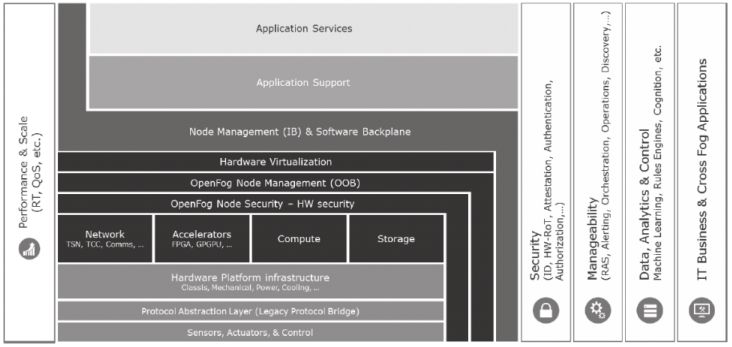
Figure 1—OpenFog Alliance Fog Computing Reference Architecture (1) Fog Computing Nodes: Primarily include node resources, node management, protocol abstraction layers, etc. Node resources include computing, storage, networking, accelerators, etc.; node management includes hardware configuration management and security protection; the protocol abstraction layer implements adaptation and docking of terminal devices such as sensors, supporting compatibility and interoperability between heterogeneous terminals and fog nodes. (2) Software: Primarily includes three layers: node management and software backplane, application support, and application services. Node management is responsible for the software and hardware configuration and status maintenance of fog nodes or systems, ensuring their availability, reliability, and performance; the software backplane runs various software for nodes and enables communication between nodes; application support provides software for multiple applications (microservices) such as application management, runtime engines, application servers, messaging and events, security services, data storage and management, analysis tools, and frameworks; application services vary based on deployment, scenarios, resource availability, etc., mainly including connection services, support services, analysis services, integration services, UI services, etc. (3) Functional Requirements: Primarily include performance and scalability, security, manageability, data analysis and control, IT services, and cross-node applications. This includes: matching traffic models based on scenario requirements to ensure isolation and non-interference between nodes; enhancing scalability through virtualization and container technologies; providing security for nodes, data, networks, security monitoring, and management across the entire system from the cloud to the network edge to things; manageability includes management interfaces, fog node lifecycle management, independent management layers, etc.; sinking the collection, storage, transmission, analysis, and other functions of massive data to the network edge, close to the data source, to achieve specific data processing capabilities on demand; enabling applications and services to be deployed and interoperate on demand within the fog computing system, supporting data sharing between nodes, and supporting cross-node applications. Fog computing can be used in various scenarios such as IoT, 5G, AI, etc., addressing needs for localized security, customer location awareness, flexible deployment and scalability, and low latency. Among these, IoT is a key scenario for FC, with applications in transportation, smart cities, smart buildings, industrial manufacturing, retail, healthcare, agriculture, government and military, smart homes, and operators. Some representative scenarios include smart cars and traffic control, visual security and monitoring, and smart cities. MEC MEC is a concept proposed and promoted by ETSI, evolving from Mobile Edge Computing to Multi-access Edge Computing. Among these, Mobile Edge Computing refers to providing IT service environments and cloud computing capabilities at the edge of mobile networks, sinking network services closer to mobile users on the wireless access network side, aiming to reduce latency, achieve efficient network control and service distribution, and improve user experience; Multi-access Edge Computing refers to providing IT service environments and cloud computing capabilities for application developers and content providers at the network edge, offering ultra-low latency, high bandwidth, and real-time access capabilities. The main features of MEC include: proximity access, ultra-low latency, location visibility, data analysis, etc. The system reference architecture provided by ETSI MEC is shown in Figure 2. It primarily includes the following components:
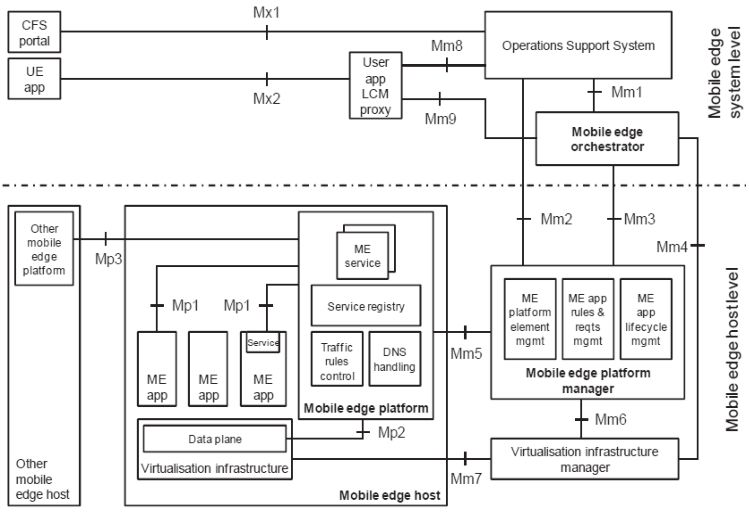
Figure 2—ETSI MEC System Reference Architecture (1) MEC Host: Composed of virtualization infrastructure and MEP, used to host various MEC applications. The data plane of the virtualization infrastructure is responsible for executing traffic rules received by the mobile edge platform and implementing traffic forwarding. MEP (MEC Platform) provides a series of functions to enable MEC applications to run on specific virtualization infrastructure and provide mobile edge services. (2) MEC Applications: Virtual machines running on the MEC host virtualization infrastructure, supporting interaction with the MEC platform to build and provide MEC services. MEC applications come with a series of rules and requirements, including required resources, maximum latency, available services, etc. These requirements are confirmed by the MEC system-level management. (3) Mobile Edge Host Management: Includes Mobile Edge Platform Manager (MEPM) and Virtualization Infrastructure Manager (VIM), managing mobile edge hosts and the applications running on them. The function of VIM (Virtualisation Infrastructure Manager) can refer to ETSI NFV VIM, primarily providing virtualization resource management functions; MEPM (Mobile Edge Platform Manager) mainly implements application lifecycle management, MEP network element management, application rules and requirements management, etc. (4) Mobile Edge System-Level Management: Includes components such as MEO and OSS. MEO (Mobile Edge Orchestrator) is the core component responsible for maintaining an overall view of the mobile edge system, activating application packages, selecting suitable mobile edge hosts based on constraints for application instantiation, triggering application instantiation and termination, and triggering application relocation. According to business needs and solution architecture, ETSI categorizes MEC scenarios into three types, each with similar architectural solutions but differing among types: 1. Customer-facing services, including gaming, remote desktop applications, augmented and assisted reality, and cognitive assistance; 2. Operator and third-party services, including activity device location tracking, big data, security, enterprise services, etc.; 3. Network performance and QoE enhancement, including content and DNS caching, performance optimization, video optimization, etc. Among these, the main scenarios include seven major areas: intelligent mobile video acceleration, monitoring video stream analysis, AR (augmented reality), intensive computing assistance, enterprise private networks, vehicle networking, and IoT gateways. Cloudlet Cloudlet is a concept proposed by Carnegie Mellon University in 2009, originating from the integration of mobile computing, IoT, and cloud computing, representing an intermediate layer in the three-tier architecture of “mobile device/IoT device—cloudlet—cloud,” which can be seen as a “data center in a box,” aimed at bringing the cloud closer to users. Based on this, OEC provides a definition of edge computing: Edge computing provides small data centers (edge nodes) close to the user side, enhancing the user experience of computing and storage resource utilization. Cloudlet primarily includes four major characteristics: deployed only in software form, possessing computing/connection/security capabilities, proximity deployment, and built on standard cloud technologies. The edge computing reference architecture provided by OEC is shown in Figure 3, including components such as mobile devices, edge servers, and backend systems. Among these, the edge server is primarily based on Cloudlet and includes three layers: (1) Infrastructure layer: includes hardware, virtualization, and management; (2) Open cloud platform: provides app runtime support environment and capabilities, and achieves unified management; (3) Applications: based on virtual machine instances, hosting various applications offloaded from mobile devices (as shown in Figure 3).
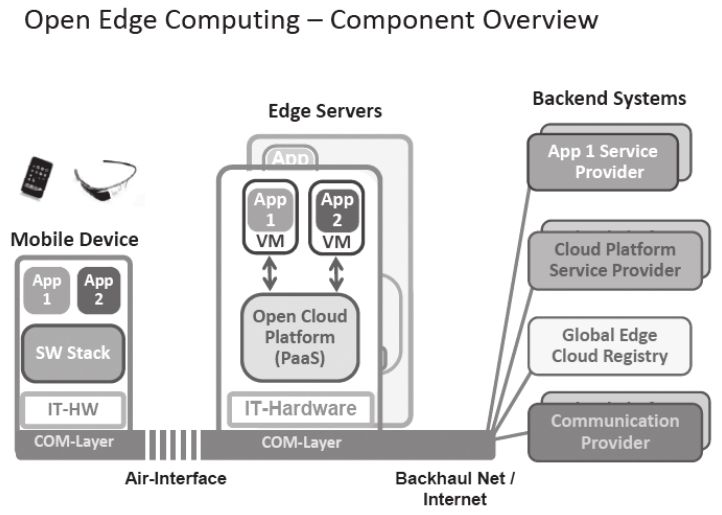
Figure 3—OEC-based Cloudlet Edge Computing System Reference Architecture Cloudlet and OEC primarily target the integration scenarios of mobile and cloud computing, applicable to four major types of scenarios, including highly responsive cloud services, extended edge analytics, privacy policy enforcement, and shielding cloud interruptions. Among these, typical scenarios include: VR, vCPE, enterprise services (such as virtual desktops), public safety, sensor data services, automotive services, mobile app optimization, Industry 4.0, drone support services, health and sports services, online gaming, and communication service optimization. Edge Computing The Edge Computing Consortium (ECC) was established in 2016 and is an active promoter of edge computing. The definition of edge computing by ECC: Edge computing is a distributed open platform that integrates network, computing, storage, and application core capabilities at the network edge, close to things or data sources, providing edge intelligent services to meet the critical needs of industry digitization in agile connectivity, real-time business, data optimization, application intelligence, and security and privacy protection. It can serve as a bridge connecting the physical and digital worlds, enabling smart assets, smart gateways, smart systems, and smart services. ECC believes that edge computing and cloud computing are two important supports for the digital transformation of industries, and their collaboration in network, business, application, and intelligence will help support broader scenarios and greater value creation in industry digital transformation. Among these, cloud computing is suitable for non-real-time, long-cycle data, and business decision scenarios, while edge computing plays an irreplaceable role in real-time, short-cycle data, and local decision scenarios. ECC lists the main characteristics of edge computing as connectivity, data-first entry, constraints, distribution, and integration. The edge computing reference architecture proposed by ECC is shown in Figure 4, which primarily includes the following hierarchical components:
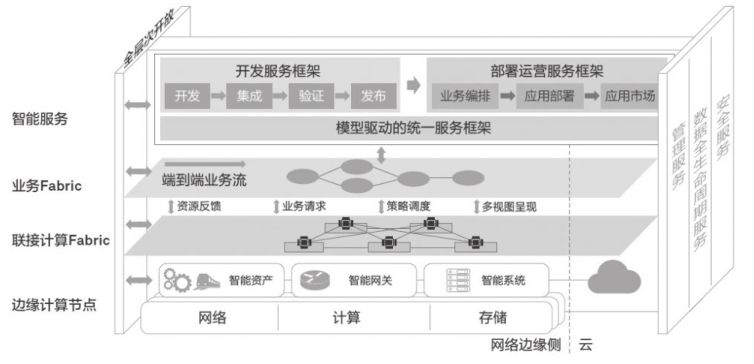
Figure 4—ECC Edge Computing Reference Architecture (1) ECN (Edge Computing Node): Composed of infrastructure layer, virtualization layer, and edge virtual services, providing general services such as bus protocol adaptation, streaming data analysis, time-series databases, security, etc., and integrating specific industry application services on demand. (2) Connectivity Computing Fabric: A virtualized connectivity and computing service layer that shields heterogeneous ECN nodes, providing resource discovery and orchestration, supporting data and knowledge model sharing between ECN nodes, supporting dynamic scheduling and optimization of business loads, and supporting distributed decision-making and policy execution. (3) Business Fabric: A modeled workflow composed of various types of functional services according to certain logical relationships, supporting the definition of workflows and workloads, visual presentation, semantic checks, and policy conflict checks, as well as version management of business fabric, services, and other models. (4) Intelligent Services: A development service framework that integrates edge computing and vertical industry model libraries through integrated development platforms and toolchains, providing full lifecycle services for models and applications; deployment operation services mainly provide three core services: business orchestration, application deployment, and application marketplace. (5) Management Services: Support unified management of terminals, networks, servers, storage, data, and applications, including isolation, security, and distributed architecture; support full lifecycle management for engineering, integration, deployment, business and data migration, integration testing, integration verification, and acceptance. (6) Data Full Lifecycle Services: Provide services such as data preprocessing, data analysis, data distribution and policy execution, data visualization, and storage. Support defining the business logic of the data full lifecycle through business fabric to meet real-time requirements. (7) Security Services: Primarily include node security, network security, data security, application security, security situational awareness, identity and authentication management, etc., covering various levels of the edge computing architecture and providing different security features on demand for different levels. Edge computing, by combining with industry use scenarios and related applications, has completed the transition from a horizontal solution platform to vertical industries based on the characteristics and needs of different industries, building numerous innovative vertical industry solutions in various sectors. Currently, the core scenarios provided by ECC mainly target IoT, with examples including: ladder networking, smart water management, smart buildings, and smart lighting. Distributed Cloud Distributed cloud is a concept proposed and promoted by ITU-T in 2016, extending the cloud computing model while maintaining the characteristics of cloud computing such as network-centricity, service provision, resource pooling and transparency, high scalability, and high reliability, while flexibly, agilely, on-demand, and intelligently providing distributed, low-latency, high-performance, secure, reliable, green energy-saving, and capability-open information infrastructure based on business/user needs, meeting the digital transformation needs of various industries in society. Distributed cloud mainly possesses the following capability characteristics: distributed, low-latency, high-performance, secure and reliable, green energy-saving, and capability-open. The distributed cloud system framework is shown in Figure 5. The distributed cloud system mainly includes two types of components:
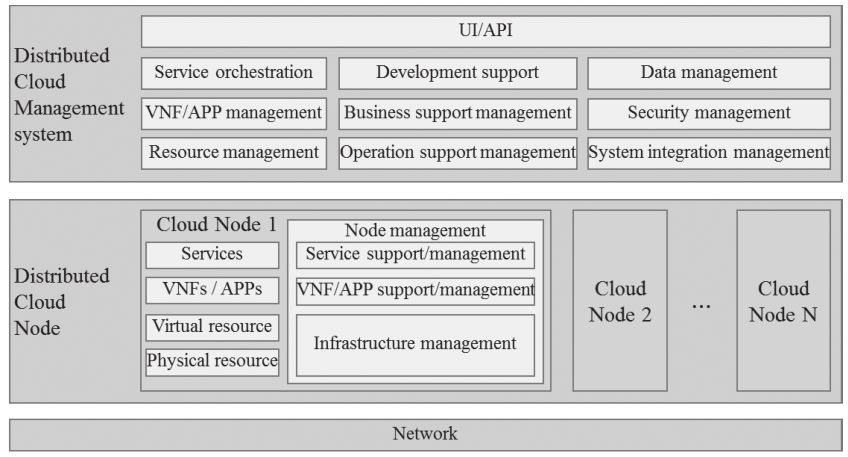
Figure 5—ITU-T Distributed Cloud System Framework (1) Distributed Cloud Nodes: Independent cloud nodes with autonomous management capabilities, providing cloud infrastructure and services, offering operational environments for various businesses and applications; based on location, node scale, and role in the distributed cloud system, they are divided into core cloud, regional cloud, edge cloud, and other types of cloud nodes; based on different business scenario needs, a flexible combination of one or more node types can be adopted to achieve on-demand deployment of business capabilities. Core cloud nodes: Based on large-scale cloud infrastructure, supporting a complete cloud service system including IaaS, PaaS, and SaaS, providing support and operational environments for various distributed cloud businesses and applications, with massive data analysis and processing capabilities. Regional cloud nodes: Similar functional architecture to core clouds, medium to large-scale cloud infrastructure, focusing on providing regional cloud infrastructure and services, supporting regional businesses and applications, meeting regional business and security, regulatory, and governance needs on demand. Edge cloud nodes: Located at the network edge, close to users and data sources, providing localized infrastructure resources, data processing capabilities, edge applications, and services. Edge cloud nodes vary in shape, capabilities, and functional requirements based on different business scenarios and deployment locations. (2) Distributed Cloud Management System: Realizes unified management of distributed cloud nodes, including unified resource management, network element and application management, business orchestration, operational management, service management, security management, R&D support, system integration management, and data management. Distributed cloud emphasizes collaboration between cloud nodes, between edge and core, providing richer business and application capabilities than single-location computing, suitable for various business scenarios, including classic cloud computing scenarios, edge computing scenarios, and edge-core collaborative scenarios, covering various business scenarios such as 5G, IoT, AI, security, CORD, CDN, and cloud services. Core Technology Analysis Fog computing, MEC, Cloudlet, edge computing, and distributed cloud are all specific implementations that integrate the “edge” concept with cloud computing technology, driven by new business demands and technological advancements. A brief analysis is shown in Table 1, where the main differences are: (1) Positioning: Fog computing aims to build a system that connects services from cloud to things, operating in collaboration with the cloud; MEC is regarded as a key technology for 5G; Cloudlet is a micro data center deployed close to the user; edge computing aims to build an open platform at the edge; distributed cloud unifies classic core cloud, regional cloud, and edge cloud into a whole. (2) Scenarios: Fog computing focuses on IoT; MEC mainly provides mobile RAN application solutions; Cloudlet realizes computing capability offloading at the network edge; edge computing primarily targets IoT intelligent services; distributed cloud aims to cover multiple scenarios. (3) Applications and Data: Fog computing, MEC, and Cloudlet focus on providing enabling and operational support environments for applications, achieving automated deployment management and business provision; edge computing and distributed cloud, in addition to supporting applications, also provide capabilities for collecting, storing, processing, analyzing, and executing policies for diverse data, constructing a hierarchical collaborative system that includes localized data processing and cloud-based big data processing (as shown in Table 1).
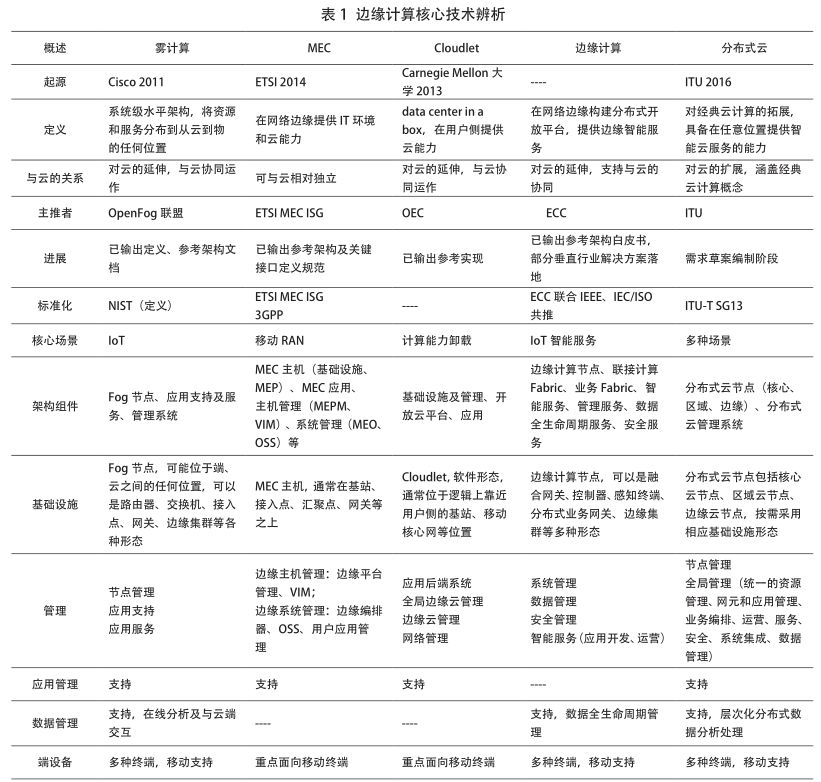
OutlookOverall, edge computing is still in its early development stage, positioned at the peak of hype on the Gartner maturity curve, and is expected to experience explosive growth in the future. The core technologies of edge computing mainly include edge nodes (such as routers, switches, base stations, vCPE, data centers, etc.), edge networks, edge management systems, edge applications, and services. Most of the hardware infrastructure and software technologies involved are already in place but need to be adapted or optimized according to edge computing requirements, such as support for computing capabilities at edge nodes, performance, reliability, and disaster recovery of edge nodes, intelligent scheduling of edge computing tasks, unified management of heterogeneous edge nodes, data distribution mechanisms and consistency, edge computing network architecture and performance optimization, large-scale edge applications and services, and edge functions and technologies (such as data refinement, video compression, and analysis), all of which require further research. Author Introduction Chen Tian,currently works at China Telecom Guangdong Research Institute, focusing on cloud computing, SDN/NFV research. Chen Nan,PhD, currently works at China Telecom Guangdong Research Institute, focusing on the Internet, cloud computing, IDC. Li Yangchun,PhD, currently works at China Telecom Guangdong Research Institute, focusing on data networks, IPv6, SDN/NFV. Fan Yongbing,PhD, senior member of the China Communications Society, senior engineer, China Telecom IP talent, currently serves as the head of the China Telecom node of the global cloud network OpenCirrus, head of the China Telecom Key Laboratory—Data Multimedia Laboratory, and a key member of the China Telecom Data Network Support Center, engaged in Internet research for a long time, currently responsible for China Telecom’s work in cloud computing, IDC, etc. References 1 OpenFog Consortium, OpenFog Reference Architecture for Fog Computing, February 20172 NIST Special Publication 800-191 (Draft), The NIST Definition of Fog Computing, August 20173 ETSI GS MEC 003 V1.1.1 (2016-03), Mobile Edge Computing (MEC); Framework and Reference Architecture4 Open Edge Computing, Open Edge Computing- From Vision to Reality, 21 June 20165 Edge Computing Consortium, Edge Computing Reference Architecture 2.0, November 20176 ITU-T, Draft Recommendation ITU-T Y.ccdc-reqts: Distributed cloud overview and high-level requirements  Forward and DisseminatePromote Knowledge Dissemination in the Field of Edge ComputingRecommended Reading
Forward and DisseminatePromote Knowledge Dissemination in the Field of Edge ComputingRecommended Reading

